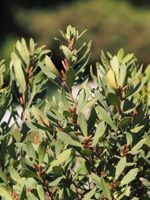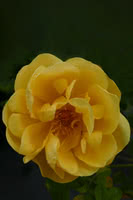Mon-Fri 9am - 5pm Mountain time
Hazeldean Rose vs Sweet Gale
Myrica gale
Rosa x Hazeldean
CUSTOM GROW
Sweet Gale is a native, nitrogen-fixing shrub known for its aromatic foliage. Tiny glands on the leaves release a balmy, bay leaf-like scent with floral and citrus notes. In spring, the yellowish male catkins provide one of the earliest sources of pollen for bees and other insects. While later in the season, the female catkins produce seeds that are eaten by waterfowl. Sweet Gale is dioecious, meaning male and female flowers occur on separate plants.
Sweet Gale thrives in wet, acidic soils and is commonly found along wetlands and lakeshores. It can help stabilize shorelines, while its dense growth provides valuable cover for wildlife. It is well-suited for naturalization, wetland restoration, and erosion control projects.
Hazeldean Rose is a perfect shrub for those who enjoy cut flowers. It blooms vigorously in late spring to early summer and is smothered in fragrant yellow double blooms that attract bees. The Hazeldean Rose is extremely cold weather hardy, making it a rare yellow rose well suited for the prairies. Resistant to blackspot, the Hazeldean Rose got her name from Robert Burns' poetry as it is "the prize of them all".

